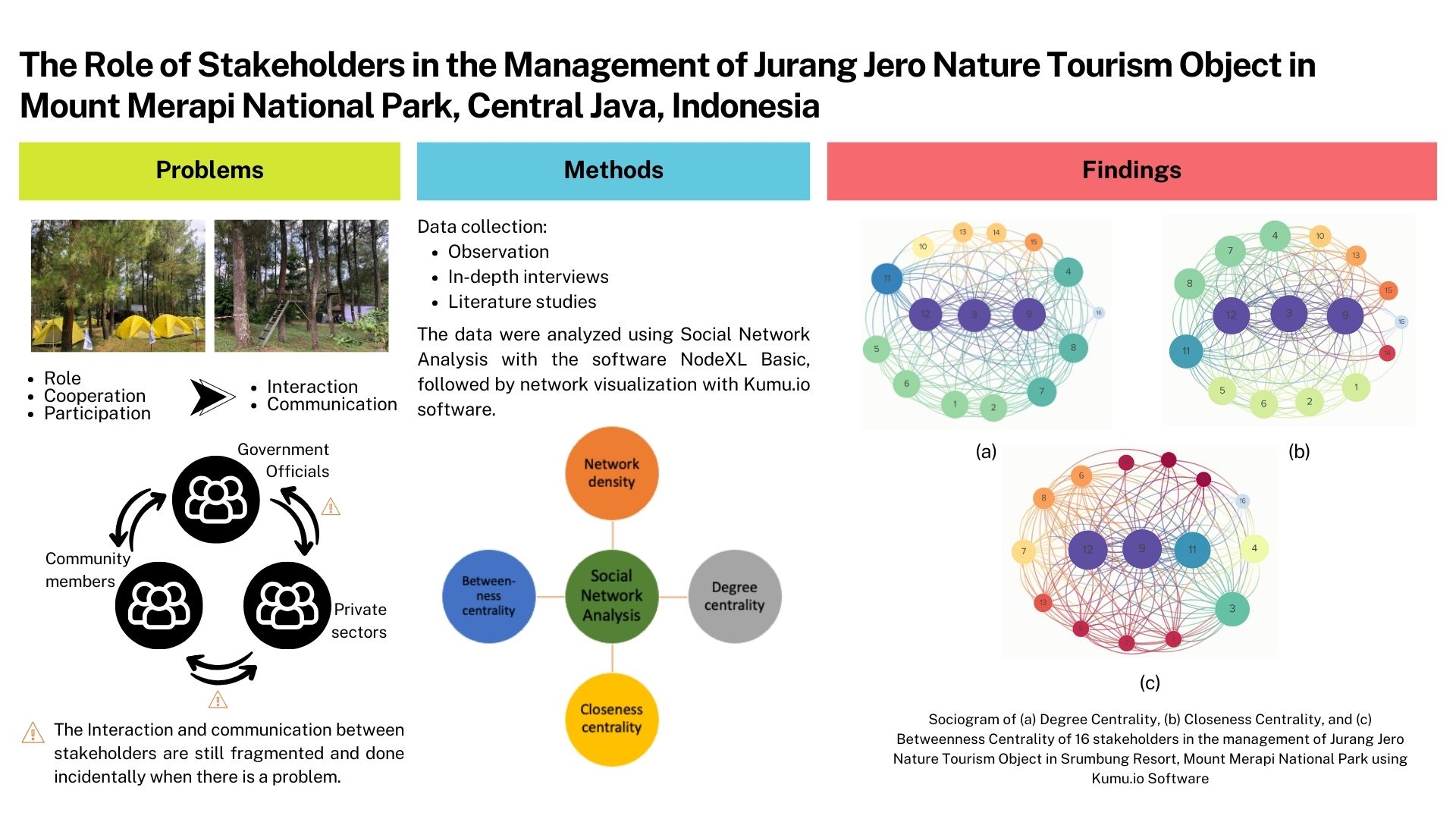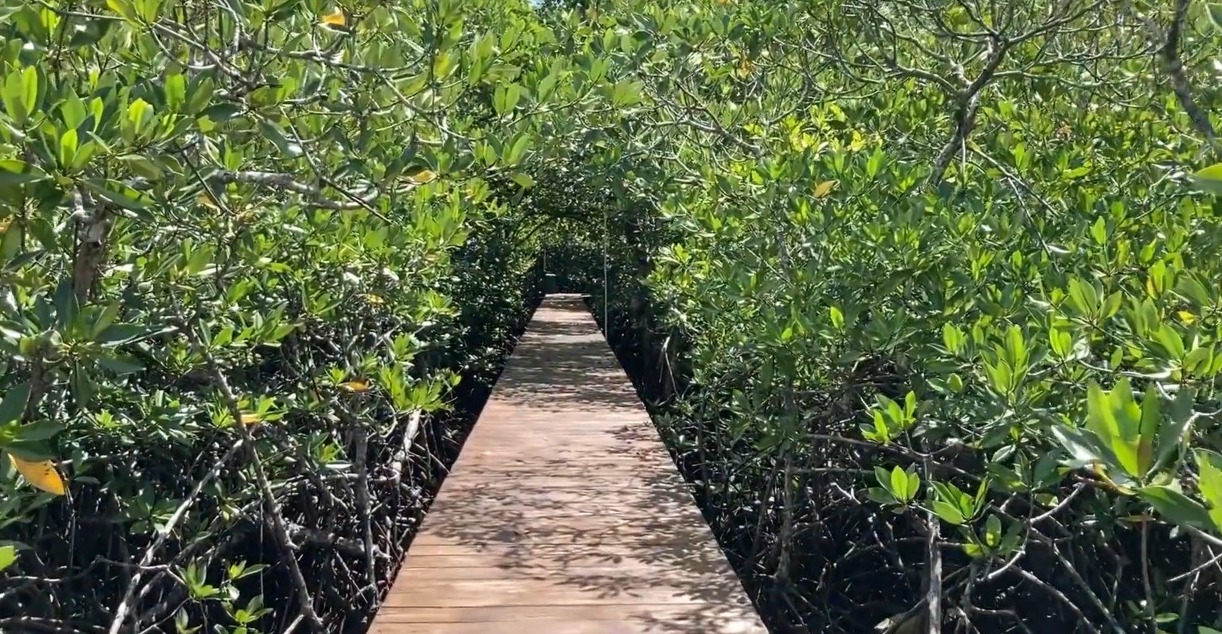Hazard Management in Tourism: A Case Study of The Senaru-Sembalun Hiking Trail, Mount Rinjani National Park, Indonesia
Abstract
Mount Rinjani (3726 masl) is the second-highest volcano in Indonesia with a newer active volcano called Mount Barujari (2376 masl) inside its crater. The mountain has become the center of tourist destinations in West Nusa Tenggara Province, with hiking as the most popular activity carried out by visitors. This study aimed to identify physical and biological hazard potentials and activities that may put visitors at risk to prepare hazard management recommendations. We carried out an interview and field observation for the study in April 2018. We used the United Nations Environment Programme (UNEP) risk assessment as a reference in biological and physical hazard analysis, and the National Patient Safety Agency for human activities. We also used ArcGIS 10.1 software to develop a map of hazard potentials. Cliff (physical hazard), tree roots (biological hazard), and running (activity) were hazards with the highest risks. All four management options offered by the UNEP, i.e., reducing risk, accepting the tolerable risk, avoiding risk, and transferring risk, were applicable in this area. We proposed that the management considering to increase local community and visitors' knowledge of hazards as a preventive measure while continuing to provide repressive measures.
References
Adinegara, G. N. J., Suprapti, N. W. S., Yasa, N. N. K., & Sukaatmadja, I. P. G. (2017). Factors that influences tourist's satisfaction and its consequences. European Journal of Business and Management, 9(8), 39–50.
Alexander, D. (2013). All-Hazards. In K. B. Penuel, M. Statler, & R. Hagen (Eds.), Encyclopedia of Crisis Management (pp. 247–250). New York: SAGE Publications, Inc. https://doi.org/10.4135/97814522759 56.n4
Aliman, N. K., Hashim, S. M., Wahid, S. D. M., & Harudin, S. (2016). Tourists' satisfaction with a destination: An investigation on visitors to Langkawi Island. British Journal of Marketing Studies, 4(5), 1–20. https://doi.org/10.5539/ijms.v8n3p173
Arnold, J. J., & Williams, P. M. (2011). Anaphylaxis: recognition and management. American Family Physicians, 84(10), 1111–1118.
Baker, R. G. (1993). Tourism and community perceptions: An examination of Mount St. Helens' Tourism as perceived by local residents. Oregon: Oregon State University.
Balch, J. K., Bradley, B. A., Abatzoglou, J. T., Nagy, R. C., Fusco, E. J., & Mahood, A. L. (2017). Human-started wildfires expand the fire niche across the United States. Proceedings of the National Academy of Sciences, 114(11), 2946–2951. https://doi.org/10.1073/pnas. 1617394114
Bjønness, I. M. (1986). Mountain hazard perception and risk-avoiding strategies among the Sherpas of Khumbu Himal, Nepal. Mountain Research and Development, 6(4), 277–292. https://doi.org/10.2307/3673369
[CDC] Centers for Disease Control and Prevention. (2005). Hypothermia-related deaths -- United States, 2003--2004. Retrieved from https://www.cdc.gov/mmwr/ preview/mmwrhtml/mm5407a4.htm
Cioccio, L., & Michael, E. J. (2007). Hazard or disaster: Tourism management for the inevitable in Northeast Victoria. Tourism Management, 28(1), 1–11. https://doi.org/10.1016/j.tourman.2005.07.015
Darlington, E. D. (1986). Look out ! It's poison ivy! Science and Children, 24(1), 10–15. Retrieved from https://www.jstor.org/stable/43166264
Erfurt, P. J. (2011). An assessment of the role of natural hot and mineral springs in health, wellness and recreational tourism. Queensland: James Cook University. Retrieved from http://eprints.jcu.edu.au/31110/
Gitapala. (2014). Standar operasional prosedur Divisi Hutan Gunung [Standard operational procedure of Forest Mountain Division]. Retrieved http://www.gitapala.tp. ugm.ac.id/standar-operasional-prosedur-divisi-hutan-gunung/
Golden, D. B. K. (2003). Stinging insect allergy. American Family Physicians, 67(12), 2541–2546. Retrieved from https://www.aafp.org/afp/2003/0615/p2541.pdf
Gupta, S. P. (2013). Hazard, Definition of. In K. B. Penuel, M. Statler, & R. Hagen (Eds.), Encyclopedia of Crisis Management (pp. 441–442). New York: SAGE Publications, Inc. https://doi.org/10.4135/9781452 275956.n151
Healthline Editorial, T., & Jewell, T. (2017). Hot and cold: Extreme temperature safety. Retrieved from https://www.healthline.com/health/extreme-temperature-safety#extreme-cold-temperatures
Helicon. (2018). Fog. In Helicon (Ed.), The Hutchinson unabridged encyclopedia with atlas and weather guide. Abington: Helicon.
Heriyanto, N. M., & Mukhtar, A. S. (2011). Gangguan satwaliar di lahan pertanian sekitar Taman Nasional Meru Betiri, Jawa Timur. Jurnal Penelitian Hutan Dan Konservasi Alam, 8(1), 55–63. https://doi.org/10.20886/ jphka.2011.8.1.55-63
Jubenville, A., Twight, B. W., & Becker, R. H. (1987). Outdoor recreation management: Theory and application (Revised an). State College: Venture Publishing, Inc.
Kumpulainen, S. (2006). Vulnerability concepts in hazard and risk assessment. Natural and technological hazards and risks affecting the spatial development of European regions. Geological Survey of Finland, Special Paper 42, 65–74.
Kurniawan, E. (2004). Panduan mendaki gunung dalam infografis. Jakarta, Indonesia: Tabloid Bola.
Kwak-Hefferan, E. (2007). Hike like a pro. Retrieved from https://search-proquest-com.ezproxy.library.uwa.edu.au/docview/2030696431?accountid=14681
Kwon, Y. G., & Park, H. J. (2002). Factor analysis of safety for
visitors to a mega-event. International Journal of Occupational Safety and Ergonomics, 8(3), 365–375. https://doi.org/10.1080/10803548.2002.11076536
Leland, J. (2010). Poison ivy. In Learning the valley: Excursions into the Shenandoah Valley (pp. 57–61). United States: Columbia, South Carolina: University of South Carolina Press.
Mardiah, A., Rizaldi, & Novarino, W. (2015). Agresi provokasi dan non-provokasi pada Monyet Ekor Panjang (Macaca fascicularis, Raffles 1821) terhadap pengunjung di Kawasan Gunung Meru. Jurnal Biologi Universitas Andalas, 4(4), 258–263. https://doi.org/10.25077/jbioua.4.4.258-263.2015
Meilani, R., Muthiah, J., & Muntasib, E. K. S. H. (2018). Reducing the risk of potential hazard in tourist activities of Mount Bromo. IOP Conference Series: Earth and Environmental Science, 149, 012021. https://doi.org/10. 1088/1755-1315/149/1/012021
Muthiah, J., Muntasib, E. K. S. H., & Meilani, R. (2018). Tourism hazard potentials in Mount Merapi: how to deal with the risk. IOP Conference Series: Earth and Environmental Science, 149, 012020. https://doi.org/10. 1088/1755-1315/149/1/012020
Naude, M. (n.d.). There & back safely: Hiking safety considerations, information and protocol. Bridgetown: Cape Nature.
[NPSA] National Patient Safety Agency. (2008). A risk matrix for risk managers. London: The National Patient Safety Agency. https://doi.org/10.1149/1.1342180
[OSHA] Occupational Safety and Health Administration. (2002). Job hazard analysis (Revised ed, Vol. 2002). Washington DC: U.S. Department of Labor Occupational Safety and Health Administration (OSHA).
Palmer, C. (2002). 'Shit happens': The selling of risk in extreme sport. The Australian Journal of Anthropology, 13(3), 323–336. https://doi.org/10.1111/j.1835-9310.2002.tb00213.x
Pickering, C. M., Harrington, J., & Worboys, G. (2003). Environmental impacts of tourism on the Australian Alps Protected Areas, Judgments of Protected Area Managers. Mountain Research and Development, 23(3), 247–254. https://doi.org/10.1659/0276-4741(2003)023[0247: EIOTOT]2.0.CO;2
Pigram, J. (1983). Outdoor recreation and resource management. New York: St. Martin's Press, Inc.
Pradhany, R. C., Widyastuti, S. K., & Wandia, I. N. (2016). Aktivitas harian monyet ekor panjang (Macaca fascicularis) yang telah divasektomi di Wenara Wana Ubud. Indonesia Medicus Veterinus, 5(3), 240–247.
[PVMBG] Pusat Vulkanologi dan Mitigasi Bencana Geologi. 2014. Gunung Rinjani. [Internet]. [Downloaded: 29 Jan 18]. Retrived from: http://www.vsi. esdm.go.id/index.php/gunungapi/data-dasar-gunungapi/473-g-rinjani.
Saputra, K. G. W., Watiniasih, N. L., & Ginantra, I. K. (2014). Aktivitas harian kera ekor panjang (Macaca fascicularis) di Taman Wisata Alam Sangeh, Kabupaten Badung, Bali Jurnal Biologi, 18(1), 14–18.
Schwartz, L. (1941). A protective ointment against Ivy poisoning. The American Journal of Nursing, 41(6), 675–678. https://doi.org/10.1097/00000446-194106 000-00011
Soputan, G. E. M., Sompie, B. F., & Mandagi, R. J. M. (2014). Manajemen resiko kesehatan dan keselamatan kerja (K3) (Studi kasus pada pembangunan gedung SMA Eben Haezar). Jurnal Ilmiah Media Engineering, 4(4), 229–238.
Suharto. (2016). Studi tentang keamanan dan keselamatan pengunjung hubungannya dengan citra destinasi (Studi kasus Gembira Loka Zoo). Jurnal Media Wisata, 14(1), 287–304. https://doi.org/10.36276/mws.v14i1.149
Sukarmin, Y. (1995). Persiapan fisik bagi pendaki gunung: Sebuah alternatif pencegahan kecelakaan. Cakrawala Pendidikan, 1, 91–102.
Sukthana, Y., Lekkla, A., Sutthikornchai, C., Wanapongse, P., Vejjajiva, A., & Bovornkitti, S. (2005). Spa, springs and safety. Southeast Asian J Trop Med Public Health, 36(suppl 4), 10–16.
Sumann, G., Hochholzer, T., Faulhaber, M., & Burtscher, M. (2015). High-altitude mountaineering made safer. Trauma, 17(1), 4–16. https://doi.org/10.1177/1460408614531878
[UNEP] United Nations Environment Programme. (2008). Disaster risk management for coastal tourism destinations responding to climate change: A practical guide for decision makers. Paris & Santo Domingo: United Nations Environment Programme (UNEP) and Caribbean Alliance for Sustainable Tourism (CAST).
[UNISDR] United Nations Office for Disaster Risk Reduction. (2004). Living with risk: A global review of disaster reduction initiatives (Vol. 1). New York and Geneva: UNISDR. Retrieved from http://www.unisdr.org/files/657_lwr1.pdf
[UNISDR] United Nations Office for Disaster Risk Reduction. (2015). Sendai framework for disaster reduction 2015-2030. Geneva: UNISDR. Retrieved from http://www.unisdr.org/files/43291_sendaiframeworkfordrren.pdf
Vernillo, G., Giandolini, M., Edwards, W. B., Morin, J.-B., Samozino, P., Horvais, N., & Millet, G. Y. (2017). Biomechanics and physiology of uphill and downhill running. Sports Medicine, 47(4), 615–629. https://doi.org/10.1007/s40279-016-0605-y
Wardana, R. A., Kahar, S., & Suprayogi, A. (2015). Penyajian peta jalur pendakian Gunung Rinjani berbasis platform android. Jurnal Geodesi Undip, 4(2), 94–100.
Wilks, J., & Moore, S. (2004). Tourism risk management for the Asia-Pacific Region: An authoritative guide for managing crises and disasters. Gold Coast MC QLD: CRC for Sustainable Tourism Pty Ltd. Retrieved from http://www.aerohabitat.eu/uploads/media/25-01-2005_-_Tourism_Risk_Management_in_Asia_Pacific__1MB_.pdf
Authors

This work is licensed under a Creative Commons Attribution 4.0 International License.
Jurnal Manajemen Hutan Tropika is an open access journal which means that all contents is freely available without charge to the user or his/her institution. Users are allowed to read, download, copy, distribute, print, search, or link to the full texts of the articles in this journal without asking prior permission from the publisher or the author. This is in accordance with the Budapest Open Access Initiative (BOAI) definition of open access.







